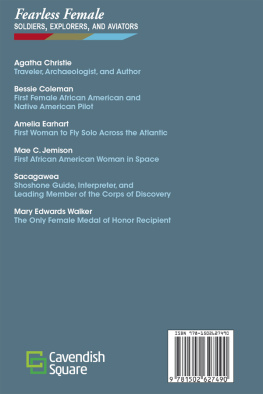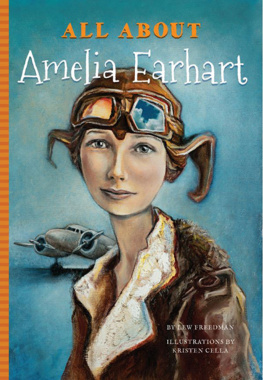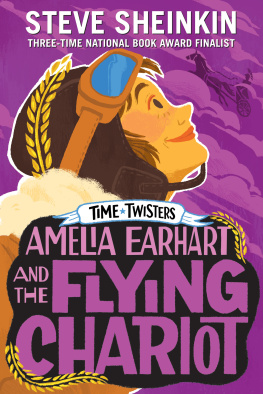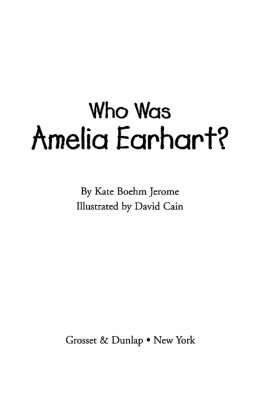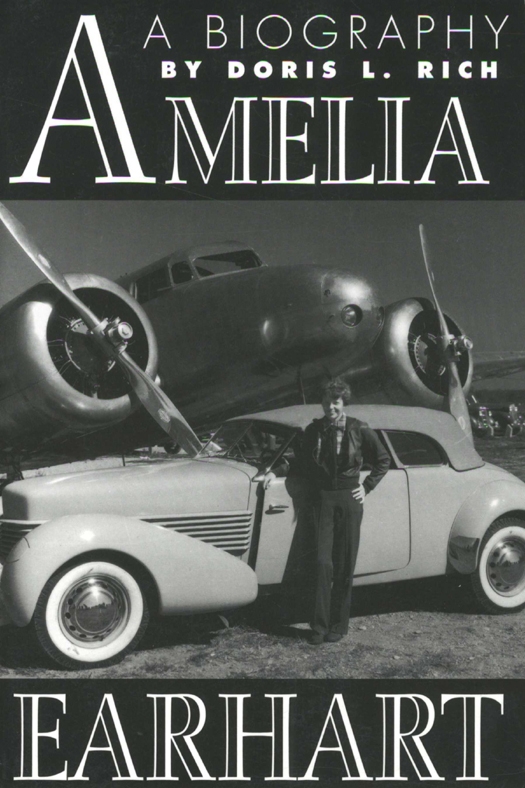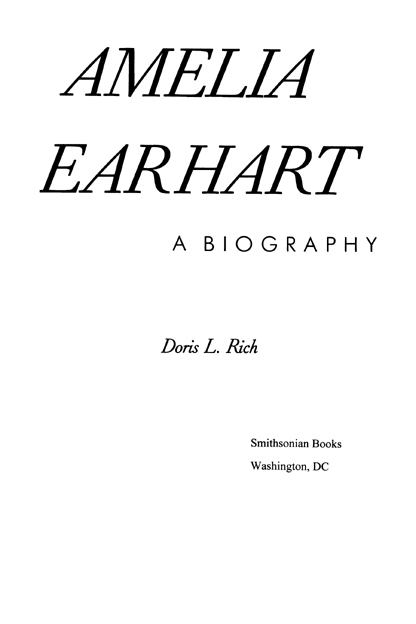Copyright 1989, 2010 by the Smithsonian Institution.
All rights are reserved.
This book was edited by Therese Boyd and designed by Alan Carter.
Library of Congress Cataloging-in-Publication Data
Rich, Doris L.
Amelia Earhart : a biography / by Doris L. Rich.
p. cm. Foreword by Jeana Yeager.
Bibliography: p.
Summary: A biography of the famous aviatrix who disappeared in the South Pacific on an around-the-world flight attempt in 1937.
eISBN: 978-1-58834-382-6
1. Earhart, Amelia, 1897-1937. 2. Air pilotsUnited StatesBiography. [1. Earhart, Amelia, 1897-1937. 2. Air pilots.] I. Title.
TL 540. E 3 R 53 1989
629.13092dc20 89-32181
British Library Cataloguing-in-Publication Data available.
For permission to reproduce individual illustrations appearing in this book, please correspond directly with the owners of the images, as stated in the picture captions. Smithsonian Books does not retain reproduction rights for these illustrations individually or maintain a file of addresses for photo sources.
v3.1
For Stanley
and our children
Christopher, Lawrence, and Deborah
CONTENTS
Note numbers are not used in this book. Instead, as a pleasurable convenience to the reader, notes are printed at the back of the book and are identified by page number and an identifying phrase or quotation from the text.
FOREWORD
I am often asked whether Amelia Earhart was one of my childhood idols.
The simple answer is no. I grew up very much a loner, very quiet, and I never had anyone that I consciously modeled my self after. But I was always ready to reach out and live my fantasies, to explore my own capabilities, to challenge myselfand to this extent I believe that many young people have been touched by her example and spirit.
For many years, however, I was more interested in horses than aircraft. I obtained my pilots license at the age of twenty-six primarily so that I could fly helicopters, which reminded me of the dragonflies I had admired as a child. My full absorption in the world of aviation did not transpire until I met Dick Rutan in 1980 and joined in the design and testing of experimental aircraft. We soon began setting records for speed and distance, as we pursued the dream of building and flying the first aircraft capable of circling the world nonstop without refueling.
That dreamwhich was realized by the flight of Voyager in December 1986certainly reminded us of Amelia and her own courageous attempt at an around-the-world flight. But it was not until I received a copy of this books manuscript that I had actually read an account of her life. The similarities between her goals and enthusiasms and my own are almost spookysimilarities such as a love for horses, a competitive interest in setting records, and an inherent stubbornness. A lot of the other ingredients of her lifethe long hours, the physical exhaustionalso strike familiar chords.
This book tells us of a gifted womans lessons in dreaming and work and determination. Her achievements were worth all the physical discomforts and dangers she endured in seizing that one rare chance offered to so few: to be the first.
Jeana Yeager
Nipomo, California
ACKNOWLEDGMENTS
Much of the material in this book came from special collections and the archives of the following libraries and organizations: National Archives, Library of Congress, Martin Luther King Library and Society of Woman Geographers, all in Washington, D.C.; Arthur and Elizabeth Schlesinger Library, Radcliffe College; Ninety-Nines, Inc.; J. B. Carruthers Aviation Collection, Harvey Mudd College; Charles Dawson History Center of Harrison, New York; West Virginia and Regional History Collection, West Virginia University Library; Special Collections, Purdue University Libraries; Archives of Contemporary History, University of Wyoming; Cochran Papers, Dwight D. Eisenhower Library; Oral History Collection, Butler Library, Columbia University in the City of New York; Aero Club of France; North Hollywood Amelia Earhart Regional Library; Zonta International; Swarthmore College Peace Collection; and the Office of Public Information, Lockheed California Company.
In all of them, staff members were invariably patient and helpful. I wish to thank in particular Kenneth Dowden, Thomas Branigar, Dr. Virginia Purdy, Edythe Caro, Loretta Gragg, Eleanor Mitchell, Dr. David Kuhner, Jeri Nunn, Robert C. Ferguson, Roy A. Blay, Herbert Bowen, Ginger BeVard, Marian Holt, Helen Bergan, Emmett D. Chisum, Eunice E. Spackman, and Lynn Durkee.
I spent most of the first three years of my six years of research at the library of the National Air and Space Museum of the Smithsonian Institution. The staff members who gave me guidance and encouragement, as well as information, include Phil Edwards, Larry Wilson, Robert Dreeson, Frank Piatropaoli, Peter Suthard, and Mary Pavlovich. I thank them all.
I am grateful for the interviews given me, especially by Amelias sister, Muriel Earhart Morrissey; by Amelias stepson, David Binney Putnam, and his daughter, Sally Putnam Chapman; and by Margaret Haviland Lewis, Donna Kinner Hunter, Winfield Kinner, Jr., and Marian Stabler. The late pilot-author Don Dwiggins gave me the papers of Paul Mantz, and Richard Sanders Allen, identification of all of Earharts planes.
Others who gave me interviews were: Capt. Ralph Barnaby, USN (Ret.), Mrs. James E. Bassett, Jr., Melba Gorby Beard, Albert Bresnick, Jessie B. Chamberlin, Harvey C. Christen, Marie Christiansen, Phyllis Fleet Crary, Harkness Davenport, R. E. G. Davies, Susan Dexter, Shirley Dobson-Gilroy, Lucille Emch, Col. Vincent Ford, USAF (Ret.), Paul Garber, Eddie Gorski, Mrs. James G. Haizlip, Mrs. Clifford Henderson, Charles Hill, Terry Gwynne-Jones, Charles LeBoutillier, John L. Maddux, Jim Montijo, Edna Whiting Nisewaner, Elise von R. Owen, Frank Pine, Paul Rafford, Ogden Reid, Whitelaw Reid, Pat H. V. Riley, Vivian Maatta Sims, Neta Snook Southern, Clair C. Stebbins, Nancy Hopkins Tier, Evelyn Bobbi Trout, Mrs. Robert W. Trump, Maj. Gen. Leigh Wade, USAF (Ret.), Dr. Max Ward, Bradford Washburn, Fay Gillis Welles, Patrick Welsh, Edna Gardner Whyte, Bernard Wiesman, Margaret and Benson Workman, C. L. Zakhartchenko and Lt. Cmdr. Thomas Zinavage, USN (Ret.).
Information through correspondence came from Virginia L. Ames, Mrs. Bernt Balchen, Michelle Birnbaum, Eleanor Merrick Bissell, Pam Blittersdorf, Doris Brell, Jane Dow Bromberg, Mrs. Robert C. Canavello, Masataka Chihaya, Anne F. Cooper, Louise Van Dyne Cotterman, Emma Encinas DeGuitierrez, Jack Elliott, Elizabeth Braun Ernst, Doris H. Farr, Harold C. Field, Herbert O. Fisher, Ella May Frazer, Eddie Fritts, Betty Huyler Gillies, R. J. Hyland, David Jones, Susan Kiner, Valerie F. Levitan, Anne Morrow Lindbergh, Ellen C. Masters, Clinton and Marian Morrison, Carole Osborne, Ben R. Rich, Dorothy Schaeffer, Richard G. Strippel, Anne Saunders, Nicholas Meredith Turner, Charles and Anne Thielen, W. M. Tegerdine, and Margaret Warren.
I am deeply indebted to Claudia M. Oakes, Curator of Aeronautics at the Air and Space Museum of the Smithsonian Institution; to Jacqueline Hubbard, author and friend; and to Ann Elmo, my agent; all of whom read the manuscript and made helpful suggestions. My thanks also to my life-long friend, Capt. Roger Pineau, USNR (Ret.), to Chris Prouty Rosenfeld, Nonna Cheatham, Luree Miller, Susan Dexter, and Julia Dean for their interest and support, and to Felix C. Lowe, Ruth Spiegel, and Therese Boyd for editorial guidance.



